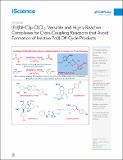Files in this item
[Pd(NHC)(μ-Cl)Cl]2 : versatile and highly reactive complexes for cross-coupling reactions that avoid formation of inactive Pd(I) off-cycle products
Item metadata
| dc.contributor.author | Zhou, Tongliang | |
| dc.contributor.author | Ma, Siyue | |
| dc.contributor.author | Nahra, Fady | |
| dc.contributor.author | Obled, Alan M.C. | |
| dc.contributor.author | Poater, Albert | |
| dc.contributor.author | Cavallo, Luigi | |
| dc.contributor.author | Cazin, Catherine S.J. | |
| dc.contributor.author | Nolan, Steven P. | |
| dc.contributor.author | Szostak, Michal | |
| dc.date.accessioned | 2020-08-10T11:30:02Z | |
| dc.date.available | 2020-08-10T11:30:02Z | |
| dc.date.issued | 2020-08-21 | |
| dc.identifier | 269529090 | |
| dc.identifier | 7513cf3e-57fd-47d8-a961-ab68a59628aa | |
| dc.identifier | 85088973933 | |
| dc.identifier | 000564153700005 | |
| dc.identifier.citation | Zhou , T , Ma , S , Nahra , F , Obled , A M C , Poater , A , Cavallo , L , Cazin , C S J , Nolan , S P & Szostak , M 2020 , ' [Pd(NHC)(μ-Cl)Cl] 2 : versatile and highly reactive complexes for cross-coupling reactions that avoid formation of inactive Pd(I) off-cycle products ' , iScience , vol. 23 , no. 8 , 101377 . https://doi.org/10.1016/j.isci.2020.101377 | en |
| dc.identifier.issn | 2589-0042 | |
| dc.identifier.other | RIS: urn:BA79636720BBE919E30F6B5EE065F0BA | |
| dc.identifier.uri | https://hdl.handle.net/10023/20439 | |
| dc.description | Authors thank Rutgers University (M.S.), the NSF (CAREER CHE-1650766, M.S.), and the NIH (1R35GM133326, M.S.) for financial support. The Bruker 500 MHz spectrometer used in this study was supported by the NSF-MRI grant (CHE-1229030). For work conducted in Belgium, S.P.N. and C.S.J.C. wish to thank the UGent BOF (starter and senior research grants). Umicore AG is thanked for gifts of materials. A.P. is a Serra Húnter Fellow and ICREA Academia Prize 2019 holder. A.P. thanks the Spanish MICINN for project PGC2018-097722-B-I00. | en |
| dc.description.abstract | The development of more reactive, general, easily accessible, and readily available Pd(II)–NHC precatalysts remains a key challenge in homogeneous catalysis. In this study, we establish air-stable NHC–Pd(II) chloro-dimers, [Pd(NHC)(μ-Cl)Cl]2, as the most reactive Pd(II)–NHC catalysts developed to date. Most crucially, compared with [Pd(NHC)(allyl)Cl] complexes, replacement of the allyl throw-away ligand with chloride allows for a more facile activation step, while effectively preventing the formation of off-cycle [Pd2(μ-allyl)(μ-Cl)(NHC)2] products. The utility is demonstrated via broad compatibility with amide cross-coupling, Suzuki cross-coupling, and the direct, late-stage functionalization of pharmaceuticals. Computational studies provide key insight into the NHC–Pd(II) chloro-dimer activation pathway. A facile synthesis of NHC–Pd(II) chloro-dimers in one-pot from NHC salts is reported. Considering the tremendous utility of Pd-catalyzed cross-coupling reactions and the overwhelming success of [Pd(NHC)(allyl)Cl] precatalysts, we believe that NHC–Pd(II) chloro-dimers, [Pd(NHC)(μ-Cl)Cl]2, should be considered as go-to precatalysts of choice in cross-coupling processes. | |
| dc.format.extent | 10337879 | |
| dc.language.iso | eng | |
| dc.relation.ispartof | iScience | en |
| dc.subject | QD Chemistry | en |
| dc.subject | DAS | en |
| dc.subject.lcc | QD | en |
| dc.title | [Pd(NHC)(μ-Cl)Cl]2 : versatile and highly reactive complexes for cross-coupling reactions that avoid formation of inactive Pd(I) off-cycle products | en |
| dc.type | Journal article | en |
| dc.contributor.institution | University of St Andrews. School of Chemistry | en |
| dc.identifier.doi | https://doi.org/10.1016/j.isci.2020.101377 | |
| dc.description.status | Peer reviewed | en |
This item appears in the following Collection(s)
Items in the St Andrews Research Repository are protected by copyright, with all rights reserved, unless otherwise indicated.

